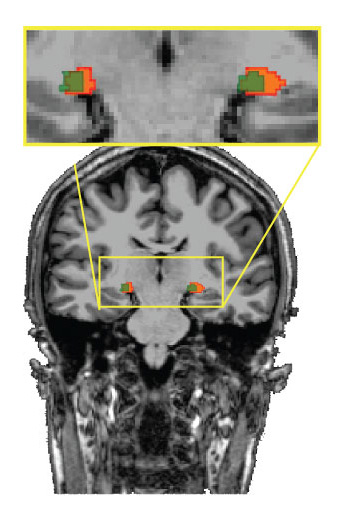Results Challenge Conventional Wisdom About Where the Brain Begins Processing Visual Information

Tong Lab, Vanderbilt University Localization of the human lateral geniculate nucleus, using high-resolution functional MRI (orange) and anatomical MRI (green).
Now, however, a brain imaging study – published online by the journal Nature Neuroscience on Mar. 2 – challenges this basic assumption. Using high-resolution functional magnetic resonance imaging (fMRI), a team of researchers from Vanderbilt and Boston universities, have discovered that more complex processing occurs in the initial stages of the visual system than previously thought.
Specifically, they have found evidence of processing in the human lateral geniculate nucleus (LGN), a small node in the thalamus in the middle of the brain that relays nerve impulses from the retina to the primary visual cortex.
An important function of the visual cortex is the processing of rudiments of shape, the angles of lines and edges, which are important for defining the outlines of objects. The researchers found that the human LGN is also sensitive to the orientation of lines and that this effect is enhanced when a person simply pays attention to the orientations in an image.
“Our results demonstrate that even the simplest brain structures may play a fundamental role in complex neural processes of perception and attention,” said Frank Tong, professor of psychology at Vanderbilt, who conducted the study with postdoctoral fellow Michael Pratte and Sam Ling at Boston University.
“They also highlight how higher cortical areas can influence and modulate how we see by modifying the responses of neurons at the earliest stages in the visual pathway through feedback connections.”
“The findings challenge the conventional wisdom about how and where in the brain the processing of visual orientation information first occurs,” commented Michael A. Steinmetz, acting director of the Division of Extramural Research at the National Eye Institute, which provided funding for the study.
“The research also underscores the concept that the perception of visual stimuli evolves from dynamic processes in widely distributed networks in the brain.”
The research was supported by National Institutes of Health grants R01 EY01782 and R01 EB000461 and NIH Fellowship F32-EY022569.
Contact Information
David Salisbury
Senior Research Writer
david.f.salisbury@vanderbilt.edu
Phone: 615-343-6803
Mobile: 615-715-6842
Media Contact
All latest news from the category: Life Sciences and Chemistry
Articles and reports from the Life Sciences and chemistry area deal with applied and basic research into modern biology, chemistry and human medicine.
Valuable information can be found on a range of life sciences fields including bacteriology, biochemistry, bionics, bioinformatics, biophysics, biotechnology, genetics, geobotany, human biology, marine biology, microbiology, molecular biology, cellular biology, zoology, bioinorganic chemistry, microchemistry and environmental chemistry.
Newest articles

First-of-its-kind study uses remote sensing to monitor plastic debris in rivers and lakes
Remote sensing creates a cost-effective solution to monitoring plastic pollution. A first-of-its-kind study from researchers at the University of Minnesota Twin Cities shows how remote sensing can help monitor and…

Laser-based artificial neuron mimics nerve cell functions at lightning speed
With a processing speed a billion times faster than nature, chip-based laser neuron could help advance AI tasks such as pattern recognition and sequence prediction. Researchers have developed a laser-based…

Optimising the processing of plastic waste
Just one look in the yellow bin reveals a colourful jumble of different types of plastic. However, the purer and more uniform plastic waste is, the easier it is to…



